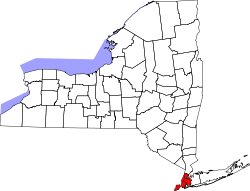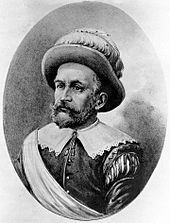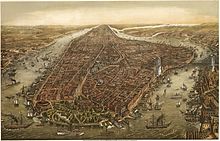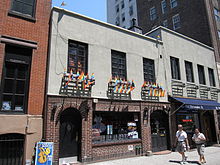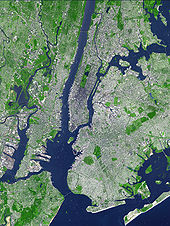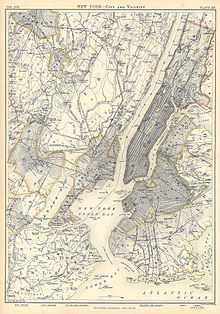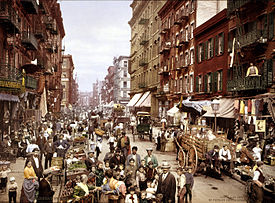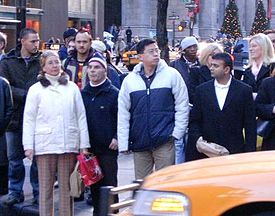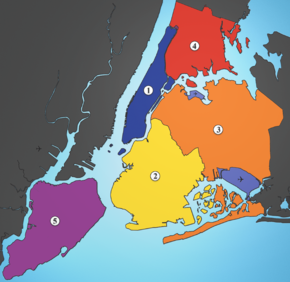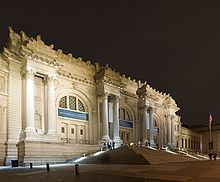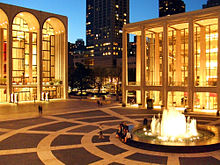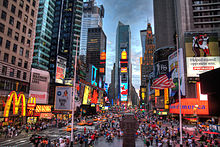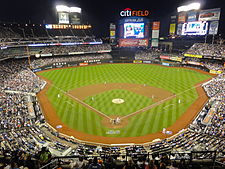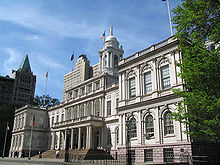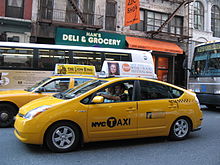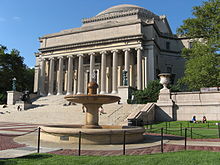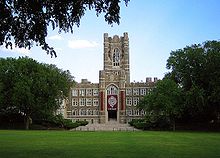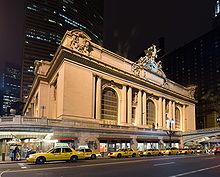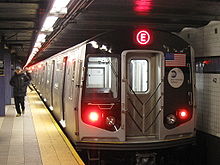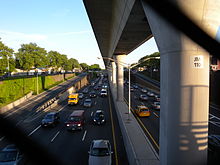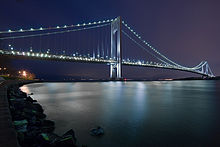
New York City
Background to the schools Wikipedia
SOS Children produced this website for schools as well as this video website about Africa. SOS mothers each look after a a family of sponsored children.
| New York City | |||
|---|---|---|---|
| — City — | |||
| City of New York | |||
| Clockwise from top: Midtown Manhattan, the United Nations Headquarters, the Statue of Liberty, the Brooklyn Bridge, Central Park, Times Square, and the Unisphere in Queens | |||
|
|||
| Nickname(s): " The Big Apple", "Gotham", "The Centre of the Universe", "Metropolis", "The City That Never Sleeps", "The Capital of the World" | |||
| Location in New York State | |||
|
|
|||
| Coordinates: 40°40.2′N 73°56.4′W Coordinates: 40°40.2′N 73°56.4′W | |||
| Country | United States of America | ||
| State | New York | ||
| Historic colony | Colony of New York | ||
| Counties | Bronx, Kings, New York, Queens, Richmond | ||
| Settled | 1624 | ||
| Incorporated | 1898 | ||
| Government | |||
| • Type | Mayor–Council | ||
| • Body | New York City Council | ||
| • Mayor | Michael Bloomberg ( I) | ||
| Area | |||
| • Total | 468.5 sq mi (1,213 km2) | ||
| • Land | 302.6 sq mi (784 km2) | ||
| • Water | 165.8 sq mi (429 km2) | ||
| Elevation | 33 ft (10 m) | ||
| Population | |||
| • Estimate (2012) | 8,336,697 | ||
| • Rank | 1st | ||
| • Density | 27,012.5/sq mi (10,429.6/km2) | ||
| • Metro | 18,897,109 ( 1st) | ||
| • CSA | 22,085,649 ( 1st) | ||
| Demonym | New Yorker | ||
| Time zone | Eastern (EST) ( UTC-5) | ||
| • Summer ( DST) | EDT ( UTC-4) | ||
| ZIP code(s) | 100xx–104xx, 11004–05, 111xx–114xx, 116xx | ||
| Area code(s) | 212, 347, 646, 718, 917, 929 | ||
| FIPS code | 36-51000 | ||
| GNIS feature ID | 975772 | ||
| Website | www.nyc.gov | ||
New York is the most populous city in the United States and the centre of the New York Metropolitan Area, one of the most populous urban agglomerations in the world. The city is referred to as New York City or the City of New York to distinguish it from the State of New York, of which it is a part. A global power city, New York exerts a significant impact upon commerce, finance, media, art, fashion, research, technology, education, and entertainment. The home of the United Nations Headquarters, New York is an important centre for international diplomacy and has been described as the cultural capital of the world.
Located on one of the world's largest natural harbors, New York City consists of five boroughs, each of which is a state county. The five boroughs— The Bronx, Brooklyn, Manhattan, Queens, and Staten Island—were consolidated into a single city in 1898. With a Census-estimated 2012 population of 8,336,697 distributed over a land area of just 302.64 square miles (783.8 km2), New York is the most densely populated major city in the United States. As many as 800 languages are spoken in New York, making it the most linguistically diverse city in the world. The New York City Metropolitan Area's population is the United States' largest, with 18.9 million people distributed over 6,720 square miles (17,400 km2), and is also part of the most populous combined statistical area in the United States, containing 22.1 million people as of the 2010 Census.
New York traces its roots to its 1624 founding as a trading post by colonists of the Dutch Republic, and was named New Amsterdam in 1626. The city and its surroundings came under English control in 1664 and were renamed New York after King Charles II of England granted the lands to his brother, the Duke of York. New York served as the capital of the United States from 1785 until 1790. It has been the country's largest city since 1790. The Statue of Liberty greeted millions of immigrants as they came to America by ship in the late 19th and early 20th centuries and is a globally recognized symbol of the United States and its democracy.
Many districts and landmarks in New York City have become well known to its approximately 50 million annual visitors. Times Square, iconified as "The Crossroads of the World", is the brightly illuminated hub of the Broadway theatre district, one of the world's busiest pedestrian intersections, and a major centre of the world's entertainment industry. The city hosts many world renowned bridges, skyscrapers, and parks. New York City's financial district, anchored by Wall Street in Lower Manhattan, has been called the world's leading financial centre and is home to the New York Stock Exchange, the world's largest stock exchange by total market capitalization of its listed companies. Manhattan's real estate market is among the most expensive in the world. Manhattan's Chinatown incorporates the highest concentration of Chinese people in the Western Hemisphere. Providing continuous 24/7 service, the New York City Subway is one of the most extensive rapid transit systems worldwide. Numerous colleges and universities are located in New York, including Columbia University, New York University, and Rockefeller University, which have been ranked among the top 50 in the world.
History

Early history
In the precolonial era, the area of present day New York City was inhabited by various bands of Algonquian tribes of Native Americans, including the Lenape, whose homeland, known as Lenapehoking, included Staten Island, the western portion of Long Island (including the area that would become Brooklyn and Queens), Manhattan, and the Lower Hudson Valley, including The Bronx.
The first documented visit by a European was in 1524 by Giovanni da Verrazzano, a Florentine explorer in the service of the French crown, who sailed his ship La Dauphine into New York Harbour. He claimed the area for France and named it "Nouvelle Angoulême" ( New Angoulême). In January a year later, Esteban Gomez, a Portuguese sailing for Emperor Charles V of Spain, entered New York Harbour and charted the mouth of the Hudson river which he named Rio de San Antonio. Heavy ice kept him from further exploration.
In 1609, English explorer Henry Hudson re-discovered the region when he sailed his ship the Halve Maen ("Half Moon" in Dutch) into New York Harbour while searching for the Northwest Passage to the Orient for his employer the Dutch East India Company. He proceeded to sail up what he named the North River, also called the Mauritis River, and now known as the Hudson River, to the site of the present-day New York State capital of Albany in the belief that it might represent an oceanic tributary. When the river narrowed and was no longer saline, he realized it wasn't a sea passage and sailed back downriver. He made a ten-day exploration of the area and claimed the region for his employer. In 1614 the area between Cape Cod and Delaware Bay would be claimed by the Netherlands and called Nieuw-Nederland ( New Netherland).
A permanent European presence in New Netherland began in 1624 with the founding of a Dutch fur trading settlement on Governors Island. In 1625 construction was started on a citadel and a Fort Amsterdam on Manhattan Island, later called New Amsterdam (Nieuw Amsterdam). The colony of New Amsterdam was centered at the site which would eventually become Lower Manhattan. The location of Dutch colonial Director-General Peter Minuit purchased the island of Manhattan from the Canarsie, a small band of the Lenape, in 1626 for a value of 60 guilders (about $1000 in 2006); a disproved legend says that Manhattan was purchased for $24 worth of glass beads.
In 1664, Peter Stuyvesant, the Director-General of the colony of New Netherland, surrendered New Amsterdam to the English without bloodshed. The English promptly renamed the fledgling city "New York" after the English Duke of York and Albany. At the end of the Second Anglo-Dutch War, the Dutch gained control of Run (then a much more valuable asset) in exchange for the English controlling New Amsterdam (New York) in North America. Several intertribal wars among the Native Americans and some epidemics brought on by contact with the Europeans caused sizable population losses for the Lenape between the years 1660 and 1670. By 1700, the Lenape population had diminished to 200.
In 1702, the city lost 10% of its population to yellow fever. New York suffered seven major yellow fever epidemics from 1702 to 1800.
New York grew in importance as a trading port while under British rule. It became a centre of slavery, with 42% of households holding slaves by 1730, more than any other city other than Charleston, South Carolina. Most slaveholders held a few or several domestic slaves, but others hired them out to work at labor. Slavery became integrally tied to New York's economy through the labor of slaves throughout the port, and the banks and shipping tied to the South. Discovery of the African Burying Ground in the 1990s during construction of a new federal courthouse near Foley Square revealed that tens of thousands of Africans had been buried in the area in the colonial years.
The city hosted the influential John Peter Zenger trial in 1735, helping to establish the freedom of the press in North America. In 1754, Columbia University was founded under charter by George II of Great Britain as King's College in Lower Manhattan. The Stamp Act Congress met in New York in October 1765 as the Sons of Liberty organized in the city, skirmishing over the next ten years with British troops stationed there.
The Battle of Long Island, the largest battle of the American Revolutionary War, was fought in August 1776 entirely within the modern day borough of Brooklyn. After the battle, in which the Americans were defeated, leaving subsequent smaller armed engagements following in its wake, the city became the British military and political base of operations in North America. The city was a haven for Loyalist refugees, as well as escaped slaves who joined the British lines for the freedom promised by the Crown. As many as 10,000 escaped slaves crowded into the city during the British occupation. When the British forces evacuated in 1783, they transported 3,000 freedmen for resettlement in Nova Scotia. They resettled other freedmen in England and the Caribbean.
The only attempt at a peaceful solution to the war took place at the Conference House on Staten Island between American delegates including Benjamin Franklin, and British general Lord Howe on September 11, 1776. Shortly after the British occupation began the Great Fire of New York occurred, a large conflagration which destroyed about a quarter of the buildings in the city, including Trinity Church.
In 1785, the assembly of the Congress of the Confederation made New York the national capital shortly after the war. New York was the last capital of the U.S. under the Articles of Confederation and the first capital under the Constitution of the United States. In 1789 the first President of the United States, George Washington, was inaugurated; the first United States Congress and the Supreme Court of the United States each assembled for the first time, and the United States Bill of Rights was drafted, all at Federal Hall on Wall Street. By 1790, New York had surpassed Philadelphia as the largest city in the United States.
Under New York State's "Gradual Abolition law of 1799", children of slave mothers were born to be eventually liberated but were held in indentured servitude until their mid-to-late twenties. Together with slaves freed by their masters after the Revolutionary War and escaped slaves, gradually a significant free-black population developed in Manhattan. Under such influential United States founders as Alexander Hamilton and John Jay the New York Manumission Society worked for abolition and established the African Free School to educate black children. It was not until 1827 that slavery was completely abolished in the state, and free blacks struggled afterward with discrimination. New York interracial abolitionist activism continued; among its leaders were graduates of the African Free School. The city's black population reached more than 16,000 in 1840.
In the 19th century, the city was transformed by development related to the western and cotton trades, as well as European immigration. The city adopted the Commissioners' Plan of 1811, which expanded the city street grid to encompass all of Manhattan. The 1819 opening of the Erie Canal through central New York connected the Atlantic port to the agricultural markets and commodities of the North American interior via the Hudson River and the Great Lakes. Local politics became dominated by Tammany Hall, a political machine supported by Irish and German immigrants.
Several prominent American literary figures lived in New York during the 1830s and 1840s, including William Cullen Bryant, Washington Irving, Herman Melville, Rufus Wilmot Griswold, John Keese, Nathaniel Parker Willis, and Edgar Allan Poe. Public-minded members of the old merchant elite lobbied for the establishment of Central Park, which in 1857 became the first landscaped park in an American city.
Modern history

The Great Irish Famine brought a large influx of Irish immigrants, and by 1860, one in four New Yorkers—over 200,000—had been born in Ireland. There was also extensive immigration from the German provinces, where revolutions had disrupted societies, and Germans comprised another 25% of New York's population by 1860.
Democratic Party candidates were consistently elected to local office, increasing the city's ties to the South and its dominant party. In 1861 Mayor Fernando Wood called on the aldermen to declare independence from Albany and the United States after the South seceded, but his proposal was not acted on. Anger at new military conscription laws during the American Civil War (1861–1865) led to the Draft Riots of 1863, led by ethnic Irish working class.
The situation deteriorated into attacks on black New Yorkers and their property, following fierce competition for a decade between immigrants and blacks for work. Rioters burned the Colored Orphan Asylum to the ground, but its more than 200 children escaped harm. Rioters killed an estimated 100 blacks and attacked many more, especially in the docks area. It was one of the worst incidents of civil unrest in American history. Because of the violence, many blacks left the city for Williamsburg, Brooklyn and New Jersey; the black population in Manhattan fell below 10,000 by 1865, which it had last been in 1820. The white working class had established dominance.
In 1898, the modern City of New York was formed with the consolidation of Brooklyn (until then a separate city), the County of New York (which then included parts of the Bronx), the County of Richmond, and the western portion of the County of Queens. The opening of the subway in 1904, first built as separate private systems, helped bind the new city together. Throughout the first half of the 20th century, the city became a world centre for industry, commerce, and communication. In 1904, the steamship General Slocum caught fire in the East River, killing 1,021 people on board.
In 1911, the Triangle Shirtwaist Factory fire, the city's worst industrial disaster, took the lives of 146 garment workers and spurred the growth of the International Ladies' Garment Workers' Union and major improvements in factory safety standards.
New York's non-white population was 36,620 in 1890. In the 1920s, New York City was a prime destination for African Americans during the Great Migration from the American South. By 1916, New York City was home to the largest urban African diaspora in North America. The Harlem Renaissance of literary and cultural life flourished during the era of Prohibition. The larger economic boom generated construction of competing skyscrapers that changed the skyline into its identifiable twentieth-century shape.
New York became the most populous urbanized area in the world in early 1920s, overtaking London. The metropolitan area surpassed the 10 million mark in early 1930s, becoming the first megacity in human history. The difficult years of the Great Depression saw the election of reformer Fiorello LaGuardia as mayor and the fall of Tammany Hall after eighty years of political dominance.
Returning World War II veterans created a postwar economic boom and the development of large housing tracts in eastern Queens. New York emerged from the war unscathed as the leading city of the world, with Wall Street leading America's place as the world's dominant economic power. The United Nations Headquarters (completed in 1950) emphasized New York's political influence, and the rise of abstract expressionism in the city precipitated New York's displacement of Paris as the centre of the art world.
In the 1960s, job losses due to industrial restructuring caused New York City to suffer from economic problems and rising crime rates, which extended into the 1970s. While a resurgence in the financial industry greatly improved the city's economic health in the 1980s, New York's crime rate continued to increase through the decade and into the beginning of the 1990s. By the 1990s, crime rates started to drop dramatically due to revised police strategies, improving economic opportunities, gentrification, and new residents, both American transplants and new immigrants from Asia and Latin America. Important new sectors, such as Silicon Alley, emerged in the city's economy. New York's population reached all-time highs in the 2000 Census and then again in the 2010 Census.
The city suffered the worst nationally of the September 11, 2001 attacks, when nearly 3,000 people died in the destruction of Towers 1, 2, and 7 of the World Trade Centre. A new complex, which includes One World Trade Centre, a 9/11 memorial and museum, and three other office towers, is being built on the site. The first buildings are finished and it is scheduled for completion by 2014. The World Trade Center PATH station, which was opened on July 19, 1909 as the Hudson Terminal, was also destroyed in the attack. A temporary station was built and opened on November 23, 2003. A permanent station, the World Trade Center Transportation Hub, is currently being constructed and is scheduled to be completed in the second quarter of 2014. At the time of its completion in 2013, the new One World Trade Centre will be the tallest building in the Western Hemisphere and the third-tallest building in the world by pinnacle height, with its spire reaching a symbolic 1,776 feet (541.3 m) in reference to the year of American independence. This new supertall skyscraper has been the tallest building in New York City since April 30, 2012.
Hurricane Sandy brought a destructive storm surge to New York City on the evening of October 29, 2012, flooding numerous streets, tunnels, and subway lines in Lower Manhattan and other areas of the city and cutting off electricity in many parts of the city and its suburbs. The storm and its profound impacts have prompted the discussion of constructing seawalls and other coastal barriers around the shorelines of the city and the metropolitan area to minimize the risk of destructive consequences from another such event in the future.
Geography
New York City is located in the Northeastern United States, in southeastern New York State, approximately halfway between Washington, D.C. and Boston. The location at the mouth of the Hudson River, which feeds into a naturally sheltered harbour and then into the Atlantic Ocean, has helped the city grow in significance as a trading port. Much of New York is built on the three islands of Manhattan, Staten Island, and Long Island, making land scarce and encouraging a high population density.
The Hudson River flows through the Hudson Valley into New York Bay. Between New York City and Troy, New York, the river is an estuary. The Hudson separates the city from New Jersey. The East River—a tidal strait—flows from Long Island Sound and separates the Bronx and Manhattan from Long Island. The Harlem River, another tidal strait between the East and Hudson Rivers, separates most of Manhattan from the Bronx. The Bronx River, which flows through the Bronx and Westchester County, is the only entirely fresh water river in the city.
The city's land has been altered substantially by human intervention, with considerable land reclamation along the waterfronts since Dutch colonial times. Reclamation is most prominent in Lower Manhattan, with developments such as Battery Park City in the 1970s and 1980s. Some of the natural relief in topography has been evened out, especially in Manhattan.
The city's total area is 468.9 square miles (1,214 km2). 164.1 sq mi (425 km2) of this is water and 304.8 sq mi (789 km2) is land. The highest point in the city is Todt Hill on Staten Island, which, at 409.8 feet (124.9 m) above sea level, is the highest point on the Eastern Seaboard south of Maine. The summit of the ridge is mostly covered in woodlands as part of the Staten Island Greenbelt.
Climate
Under the Köppen climate classification, New York City experiences a humid subtropical climate (Cfa) nearing the humid continental climate (Dfa), and using the 0 °C (32 °F) threshold, it is the northernmost major city on the North American continent with the humid subtropical categorization. The area averages 234 days with at least some sunshine annually, and averages 58% of possible sunshine annually, accumulating 2,400 to 2,800 hours of sunshine per annum.
Winters are cold and damp, and prevailing wind patterns that blow offshore minimize the moderating effects of the Atlantic Ocean; yet the Atlantic and the partial shielding of the Appalachians keep the city warmer in the winter than inland North American cities located at similar or lesser latitudes such as Pittsburgh, Cincinnati, and Indianapolis. The average temperature in January, the area's coldest month, is 32.1 °F (0.1 °C). However, temperatures in winter could for a few days be as low as 10 °F (−12 °C) and as high as 50 °F (10 °C). Spring and autumn are unpredictable and can range from chilly to warm, although they are usually mild with low humidity. Summers are typically hot and humid with a July average of 76.5 °F (24.7 °C). Nighttime conditions are often exacerbated by the urban heat island phenomenon, and temperatures exceed 90 °F (32 °C) on average of 17 days each summer and can exceed 100 °F (38 °C).
The city receives 49.7 inches (1,260 mm) of precipitation annually, which is fairly spread throughout the year. Average winter snowfall for 1981 to 2010 has been 26.7 inches (68 cm), but this usually varies considerably from year to year. Hurricanes and tropical storms are rare in the New York area, but are not unheard of and always have the potential to strike the area. Extreme temperatures have ranged from −15 °F (−26 °C), recorded on February 9, 1934, up to 106 °F (41 °C) on July 9, 1936.
| Climate data for New York ( Belvedere Castle, Central Park) | |||||||||||||
|---|---|---|---|---|---|---|---|---|---|---|---|---|---|
| Month | Jan | Feb | Mar | Apr | May | Jun | Jul | Aug | Sep | Oct | Nov | Dec | Year |
| Record high °F (°C) | 72 (22) |
75 (24) |
86 (30) |
96 (36) |
99 (37) |
101 (38) |
106 (41) |
104 (40) |
102 (39) |
94 (34) |
84 (29) |
75 (24) |
106 (41) |
| Average high °F (°C) | 38.3 (3.5) |
41.6 (5.3) |
49.7 (9.8) |
61.2 (16.2) |
70.8 (21.6) |
79.3 (26.3) |
84.1 (28.9) |
82.6 (28.1) |
75.2 (24.0) |
63.8 (17.7) |
53.8 (12.1) |
43.0 (6.1) |
62.0 (16.7) |
| Average low °F (°C) | 26.9 (−2.8) |
28.9 (−1.7) |
35.2 (1.8) |
44.8 (7.1) |
54.0 (12.2) |
63.6 (17.6) |
68.9 (20.5) |
67.9 (19.9) |
60.8 (16.0) |
50.0 (10.0) |
41.6 (5.3) |
32.0 (0.0) |
47.9 (8.8) |
| Record low °F (°C) | −6 (−21) |
−15 (−26) |
3 (−16) |
12 (−11) |
32 (0) |
44 (7) |
52 (11) |
50 (10) |
39 (4) |
28 (−2) |
7 (−14) |
−13 (−25) |
−15 (−26) |
| Precipitation inches (mm) | 3.65 (92.7) |
3.09 (78.5) |
4.36 (110.7) |
4.49 (114) |
4.19 (106.4) |
4.41 (112) |
4.60 (116.8) |
4.44 (112.8) |
4.28 (108.7) |
4.40 (111.8) |
4.02 (102.1) |
4.00 (101.6) |
49.92 (1,268) |
| Snowfall inches (cm) | 8.0 (20.3) |
9.4 (23.9) |
3.7 (9.4) |
.6 (1.5) |
0 (0) |
0 (0) |
0 (0) |
0 (0) |
0 (0) |
0 (0) |
.3 (0.8) |
4.8 (12.2) |
26.7 (67.8) |
| Avg. precipitation days (≥ 0.01 inch) | 10.4 | 9.2 | 10.9 | 11.5 | 11.1 | 11.2 | 10.4 | 9.5 | 8.7 | 8.9 | 9.6 | 10.6 | 121.9 |
| Avg. snowy days (≥ 0.1 inch) | 4.1 | 2.9 | 1.8 | .3 | 0 | 0 | 0 | 0 | 0 | 0 | .2 | 2.3 | 11.5 |
| Percent possible sunshine | 51 | 55 | 57 | 58 | 61 | 64 | 65 | 64 | 62 | 61 | 52 | 49 | 58 |
| Source: NOAA (1981–2010 temperature & precipitation normals, 1981–2011 snowfall normals, extremes 1871–present, sunshine through 2009) | |||||||||||||
Demographics
| City compared to State & U.S. | |||
|---|---|---|---|
| 2000 Census | NY City | NY State | U.S. |
| Total population | 8,213,839 | 18,976,457 | 281,421,906 |
| Population, percent change, 1990 to 2000 | +9.4% | +5.5% | +13.1% |
| Population density | 26,403/mi² | 402/mi² | 80/mi² |
| Median household income (1999) | $38,293 | $43,393 | $41,994 |
| Bachelor's degree or higher | 27% | 27% | 29% |
| Foreign born | 36% | 20% | 11% |
| White (non-Hispanic) | 35% | 62% | 67% |
| Black | 28% | 16% | 12% |
| Hispanic (any race) | 27% | 15% | 11% |
| Asian | 10% | 6% | 4% |
| Historical population | ||
|---|---|---|
| Year | Pop. | ±% |
| 1698 | 4,937 | — |
| 1712 | 5,840 | +18.3% |
| 1723 | 7,248 | +24.1% |
| 1737 | 10,664 | +47.1% |
| 1746 | 11,717 | +9.9% |
| 1756 | 13,046 | +11.3% |
| 1771 | 21,863 | +67.6% |
| 1790 | 49,401 | +126.0% |
| 1800 | 79,216 | +60.4% |
| 1810 | 119,734 | +51.1% |
| 1820 | 152,056 | +27.0% |
| 1830 | 242,278 | +59.3% |
| 1840 | 391,114 | +61.4% |
| 1850 | 696,115 | +78.0% |
| 1860 | 1,174,779 | +68.8% |
| 1870 | 1,478,103 | +25.8% |
| 1880 | 1,911,698 | +29.3% |
| 1890 | 2,507,414 | +31.2% |
| 1900 | 3,437,202 | +37.1% |
| 1910 | 4,766,883 | +38.7% |
| 1920 | 5,620,048 | +17.9% |
| 1930 | 6,930,446 | +23.3% |
| 1940 | 7,454,995 | +7.6% |
| 1950 | 7,891,957 | +5.9% |
| 1960 | 7,781,984 | −1.4% |
| 1970 | 7,894,862 | +1.5% |
| 1980 | 7,071,639 | −10.4% |
| 1990 | 7,322,564 | +3.5% |
| 2000 | 8,008,288 | +9.4% |
| 2010 | 8,175,133 | +2.1% |
| 2012 | 8,336,697 | +2.0% |
| Note: Census figures (1790–2010) cover the present area of all five boroughs, before and after the 1898 consolidation. For New York City itself before annexing part of the Bronx in 1874, see Manhattan#Demographics. Sources: 1698–1771, 1790–1890, 1900–1990, 2000 and 2010 Census. 2012 Census estimates. | ||
New York City is the most populous city in the United States, with an estimated record high of 8,336,697 residents as of 2012, incorporating more inmigration to the city than outmigration since the 2010 United States Census; with a population significantly greater than the combined totals of Los Angeles and Chicago, and greater than the San Francisco Bay Area's metropolitan total.
Mayor Michael R. Bloomberg immediately challenged the Census Bureau's 2010 population count of 8,175,133 as representing an undercount upon release. This amounts to about 40% of the state of New York's population and a similar percentage of the metropolitan regional population. In 2006, demographers estimated that New York's population will reach between 9.2 and 9.5 million by 2030. The city's population in 2010 was 44% white (33.3% non-Hispanic white), 25.5% black (23% non-Hispanic black), and 12.7% Asian.
Hispanics of any race represented 28.6% of the population, while Asians constituted the fastest-growing segment of the city's population between 2000 and 2010; the non-Hispanic white population declined 3 percent, the smallest recorded decline in decades; and for the first time since the Civil War, the number of blacks declined over a decade.
Two demographic points are New York City's density and ethnic diversity. In 2010, the city had a population density of 27,532 people per square mile (10,630/km²), rendering it the most densely populated of all municipalities with over 100,000 population in the United States; however, several small cities in adjacent Hudson County, New Jersey are actually more dense overall, as per the 2000 Census.
Geographically co-extensive with New York County, conversely, the borough of Manhattan's population density of 66,940 people per square mile (25,846/km²) makes it the highest of any county in the United States and higher than the density of any individual American city.
Throughout its history, the city has been a major port of entry for immigrants into the United States; more than 12 million European immigrants passed through Ellis Island between 1892 and 1924. The term " melting pot" was first coined to describe densely populated immigrant neighborhoods on the Lower East Side. By 1900, Germans constituted the largest immigrant group, followed by the Irish, Jews, and Italians. In 1940, whites represented 92% of the city's population.
Approximately 36% of the city's population is foreign-born. In New York, no single country or region of origin dominates. The ten largest sources of foreign-born individuals in the metropolitan area are the Dominican Republic, China, Jamaica, Mexico, India, Ecuador, Italy, Haiti, Colombia, and Guyana. The New York region continues to be the leading metropolitan gateway for legal immigrants admitted into the United States.

The New York City metropolitan area is ethnically diverse. It is home to the largest Jewish community outside Israel. The metropolitan area is also home to 20% of the nation's Indian Americans and at least 20 Little India enclaves, as well as 15% of all Korean Americans and four Koreatowns; the largest Asian Indian population in the Western Hemisphere; the largest Russian American, Italian American, and African American populations; the largest South American and second-largest overall Hispanic communities in the United States; and includes 6 Chinatowns in New York City alone (7 including the emerging Chinese enclave in Corona, Queens), as well as one each in Edison, New Jersey and Nassau County, Long Island, with the urban agglomeration comprising as of the 2010 Census a population of 682,265 overseas Chinese, the largest outside of Asia. The New York region continues to be by far the leading metropolitan gateway for legal immigrants admitted into the United States.
New York City alone, according to the 2010 Census, has now become home to more than one million Asian Americans, greater than the combined totals of San Francisco and Los Angeles. New York contains the highest total Asian population of any U.S. city proper. 6.0% of New York City is of Chinese ethnicity, with about forty percent of them living in the borough of Queens alone. Koreans make up 1.2% of the city's population, and Japanese 0.3%. Filipinos are the largest southeast Asian ethnic group at 0.8%, followed by Vietnamese who make up only 0.2% of New York City's population. Indians are the largest South Asian group, comprising 2.4% of the city's population, with Bangladeshis and Pakistanis at 0.7% and 0.5%, respectively.
There are substantial Puerto Rican and Dominican populations in the New York City metropolitan region. The Irish also have a notable presence; one in 50 New Yorkers of European origin carries a distinctive genetic signature on his Y chromosome inherited from the clan of Niall of the Nine Hostages, an Irish king of the fifth century A.D. or from one of the related clans of Uí Briúin and Uí Fiachrach.
The New York metropolitan area is home to a self-identifying gay and bisexual community estimated at 568,903 individuals, the largest in the United States. Same-sex marriages in New York were legalized on June 24, 2011 and were authorized to take place beginning 30 days thereafter.
New York City has a high degree of income disparity. In 2005, the median household income in the wealthiest census tract was $188,697, while in the poorest it was $9,320. The disparity is driven by wage growth in high income brackets, while wages have stagnated for middle and lower income brackets. In early 2011, the average weekly wage in New York County was $2,634, representing the highest total and absolute increase among the largest counties in the United States. New York City has ranked along with Moscow as home to the highest number of billionaires, including Mayor Michael R. Bloomberg, and in February 2013, Russian billionaire Roman Abramovich docked his $1.5 billion yacht, the world's largest, in Manhattan. Manhattan is also experiencing a baby boom that is unique among American cities. Since 2000, the number of children under age 5 living in the borough grew by more than 32%.
Cityscape
Architecture
New York has architecturally noteworthy buildings in a wide range of styles and from distinct time periods from the saltbox style Pieter Claesen Wyckoff House in Brooklyn, the oldest section of which dates to 1656, to the modern One World Trade Centre, the skyscraper currently under construction at Ground Zero in Lower Manhattan and currently the most expensive new office tower in the world.
Manhattan's skyline with its many skyscrapers is universally recognized, and the city has been home to several of the tallest buildings in the world. As of 2011, New York City had 5,937 high-rise buildings, of which 550 completed structures were at least 100 meters high, both second in the world after Hong Kong, with over 50 completed skyscrapers taller than 656 feet (200 m). These include the Woolworth Building (1913), an early gothic revival skyscraper built with massively scaled gothic detailing.
The 1916 Zoning Resolution required setback in new buildings, and restricted towers to a percentage of the lot size, to allow sunlight to reach the streets below. The Art Deco style of the Chrysler Building (1930) and Empire State Building (1931), with their tapered tops and steel spires, reflected the zoning requirements. The buildings have distinctive ornamentation, such as the eagles at the corners of the 61st floor on the Chrysler Building, and are considered some of the finest examples of the Art Deco style. A highly influential example of the international style in the United States is the Seagram Building (1957), distinctive for its façade using visible bronze-toned I-beams to evoke the building's structure. The Condé Nast Building (2000) is a prominent example of green design in American skyscrapers.
The character of New York's large residential districts is often defined by the elegant brownstone rowhouses, townhouses, and shabby tenements that were built during a period of rapid expansion from 1870 to 1930. In contrast, New York City also has neighborhoods that are less densely populated and feature free-standing dwellings. In neighborhoods such as Riverdale, Bronx; Ditmas Park, Brooklyn; and Douglaston, Queens, large single-family homes are common in various architectural styles such as Tudor Revival and Victorian.
Stone and brick became the city's building materials of choice after the construction of wood-frame houses was limited in the aftermath of the Great Fire of 1835. A distinctive feature of many of the city's buildings is the wooden roof-mounted water towers. In the 1800s, the city required their installation on buildings higher than six stories to prevent the need for excessively high water pressures at lower elevations, which could break municipal water pipes. Garden apartments became popular during the 1920s in outlying areas, such as Jackson Heights.
Parks

National Park System units within city limits
Gateway National Recreation Area contains over 26,000 acres (10,521.83 ha) in total, most of it surrounded by New York City; the New York State portion includes the Jamaica Bay Wildlife Refuge in Brooklyn and Queens, over 9,000 acres (36 km2) of salt marsh, islands and water that includes most of Jamaica Bay. Also in Queens the park includes a significant portion of the western Rockaway Peninsula, most notably Jacob Riis Park and Fort Tilden. Fort Wadsworth in Staten Island with historic pre-Civil War era Battery Weed and Fort Tompkins, and Great Kills Park with beaches, trails, and a marina also on Staten Island.
The Statue of Liberty National Monument and Ellis Island Immigration Museum are managed by the National Park Service and are located both in the states of New York and New Jersey. They are joined in the harbour by Governors Island National Monument, located in New York. Historic sites under federal management on Manhattan Island include Castle Clinton National Monument; Federal Hall National Memorial; Theodore Roosevelt Birthplace National Historic Site; General Grant National Memorial ("Grant's Tomb"); African Burial Ground National Monument; and Hamilton Grange National Memorial. Hundreds of private properties are listed on the National Register of Historic Places or as a National Historic Landmark such as, for example, the Stonewall Inn in Greenwich Village as the catalyst of the modern gay rights movement.
New York State Parks
There are seven state parks within the confines of New York City, including Clay Pit Ponds State Park, a natural area which includes extensive riding trails, and Riverbank State Park, a 28-acre (110,000 m2) facility that rises 69 feet (21 m) over the Hudson River.

New York City Department of Parks and Recreation
New York City has over 28,000 acres (110 km2) of municipal parkland and 14 miles (23 km) of public beaches. Parks in New York City include Central Park, Prospect Park, Flushing Meadows-Corona Park, Forest Park, and Washington Square Park. The largest municipal park in the city is Pelham Bay Park with 2,700 acres (1,093 ha).
- Central Park an 883-acre (3.57 km2) park in Manhattan, is the most visited city park in the United States, with 25 million visitors each year. The park contains a myriad of attractions; there are several lakes and ponds, two ice-skating rinks, the Central Park Zoo, the Central Park Conservatory Garden, the 106-acre (0.43 km2) Jackie Onassis Reservoir. Indoor attractions include Belvedere Castle with its nature center, the Swedish Cottage Marionette Theatre, and the historic Carousel. On October 23, 2012, hedge fund manager John A. Paulson announced a $100 million gift to the Central Park Conservancy, the largest ever monetary donation to New York City's park system.
- Prospect Park in Brooklyn has a 90-acre (360,000 m2) meadow, a lake and extensive woodlands. Located within the park is the historic Battle Pass, which figured prominently in the Battle of Long Island.
- Flushing Meadows–Corona Park in Queens, the city's third largest park, was the setting for the 1939 World's Fair and the 1964 World's Fair.
- Over a fifth of the Bronx's area, 7,000 acres (28 km2), is given over to open space and parks, including Van Cortlandt Park, Pelham Bay Park, the Bronx Zoo, and the New York Botanical Gardens.
- In Staten Island, the Conference House Park contains the historic Conference House, site of the only attempt of a peaceful resolution to the American Revolution, attended by Benjamin Franklin representing the Americans and Lord Howe representing the British Crown. Located within the park is the historic Burial Ridge, the largest Native American burial ground within New York City.
Boroughs
|
New York's five boroughs overview
|
||||
| Jurisdiction | Population | Land area | ||
| Borough of | County of | 1 July 2011 Estimates |
square miles |
square km |
| Manhattan | New York | 1,619,090 | 23 | 59 |
| The Bronx | Bronx | 1,408,473 | 42 | 109 |
| Brooklyn | Kings | 2,565,635 | 71 | 183 |
| Queens | Queens | 2,272,771 | 109 | 283 |
| Staten Island | Richmond | 470,728 | 58 | 151 |
|
City of New York
|
8,336,697 | 303 | 786 | |
|
State of New York
|
19,570,261 | 47,214 | 122,284 | |
| Source: United States Census Bureau | ||||
New York City is composed of five boroughs. Each borough is coextensive with a respective county of New York State as shown below.
Throughout the boroughs there are hundreds of distinct neighborhoods, many with a definable history and character to call their own. If the boroughs were each independent cities, four of the boroughs (Brooklyn, Queens, Manhattan, and The Bronx) would be among the ten most populous cities in the United States.
- Manhattan (New York County; 2009 Est. Pop.: 1,629,054) is the most densely populated borough and is home to Central Park and most of the city's skyscrapers. The borough is the financial centre of the city and contains the headquarters of many major corporations, the UN, a number of important universities, and many cultural attractions. Manhattan is loosely divided into Lower, Midtown, and Uptown regions. Uptown Manhattan is divided by Central Park into the Upper East Side and the Upper West Side, and above the park is Harlem. New York City's remaining four boroughs are collectively referred to as the "outer boroughs".
- The Bronx (Bronx County: Pop. 1,397,287) is New York City's northernmost borough, the location of Yankee Stadium, home of the New York Yankees, and home to the largest cooperatively owned housing complex in the United States, Co-op City. Except for a small section of Manhattan known as Marble Hill, the Bronx is the only section of the city that is part of the United States' mainland. It is home to the Bronx Zoo, the largest metropolitan zoo in the United States, which spans 265 acres (1.07 km2) and is home to over 6,000 animals. The Bronx is the birthplace of rap and hip hop culture.
- Brooklyn (Kings County: Pop. 2,567,098), on the western tip of Long Island, is the city's most populous borough and was an independent city until 1898. Brooklyn is known for its cultural, social and ethnic diversity, an independent art scene, distinct neighborhoods and a distinctive architectural heritage. Downtown Brooklyn is the only central core neighbourhood in the outer boroughs. The borough features a long beachfront shoreline including Coney Island, established in the 1870s as one of the earliest amusement grounds in the country.
- Queens (Queens County: Pop. 2,306,712) is geographically the largest borough and the most ethnically diverse county in the United States. Historically a collection of small towns and villages founded by the Dutch, the borough has since developed both commercial and residential prominence. Queens County is the only large county in the United States where the median income among African Americans, approximately $52,000 a year, is higher than that of White Americans. Queens is the site of Citi Field, the home of the New York Mets, and annually hosts the U.S. Open tennis tournament. Additionally, it is home to two of the three major airports serving the New York metropolitan area, LaGuardia Airport and John F. Kennedy International Airport. (The third is Newark Liberty International Airport in Newark, New Jersey.)
- Staten Island (Richmond County: Pop. 491,730) is the most suburban in character of the five boroughs. Staten Island is connected to Brooklyn by the Verrazano-Narrows Bridge and to Manhattan by way of the free Staten Island Ferry. The Staten Island Ferry is one of the most popular tourist attractions in New York City as it provides unsurpassed views of the Statue of Liberty, Ellis Island, and lower Manhattan. Located in central Staten Island, the 2,500 acres (10 km2) Greenbelt has some 28 miles (45 km) of walking trails and one of the last undisturbed forests in the city. Designated in 1984 to protect the island's natural lands, the Greenbelt comprises seven city parks.
Culture and contemporary life
New York City has been described as the cultural capital of the world by the diplomatic consulates of Iceland and Latvia and by New York's Baruch College. A book containing a series of essays titled New York, culture capital of the world, 1940–1965 has also been published as showcased by the National Library of Australia.
Tom Wolfe has quoted regarding New York's culture that:
| “ | Culture just seems to be in the air, like part of the weather. | ” |
|
—Tom Wolfe |
||
Numerous major American cultural movements began in the city, such as the Harlem Renaissance, which established the African-American literary canon in the United States. The city was a centre of jazz in the 1940s, abstract expressionism in the 1950s and the birthplace of hip hop in the 1970s. The city's punk and hardcore scenes were influential in the 1970s and 1980s, and the city has long had a flourishing scene for Jewish American literature.
The city is the birthplace of many cultural movements, including the Harlem Renaissance in literature and visual art; abstract expressionism (also known as the New York School) in painting; and hip hop, punk, salsa, disco, freestyle, Tin Pan Alley and Jazz in music. New York City has been considered the dance capital of the world. The city is also widely celebrated in popular lore, featured frequently as the setting for books, movies (see New York in film), television programs, etc.
Entertainment and performing arts
New York is a prominent location in the American entertainment industry, with films, television series, books, and other media being set there. As of 2008, New York City is the second largest centre for the film industry in the United States with 63,000 workers who were paid as much as $5 billion in wages. and by volume, New York is the world leader in independent film production. The Association of Independent Commercial producers is also based in New York City. The city has more than 2,000 arts and cultural organizations and more than 500 art galleries of all sizes.
The city government funds the arts with a larger annual budget than the National Endowment for the Arts. Wealthy industrialists in the 19th century built a network of major cultural institutions, such as the famed Carnegie Hall and The Metropolitan Museum of Art, that would become internationally established. The advent of electric lighting led to elaborate theatre productions, and in the 1880s New York City theaters on Broadway and along 42nd Street began featuring a new stage form that became known as the Broadway musical. Strongly influenced by the city's immigrants, productions such as those of Harrigan and Hart, George M. Cohan, and others used song in narratives that often reflected themes of hope and ambition.
The city's 39 largest theaters (with more than 500 seats each) are collectively known as " Broadway," after the major thoroughfare that crosses the Times Square Theatre District. This area is sometimes referred to as The Main Stem, The Great White Way or The Rialto. Lincoln Centre for the Performing Arts is home to 12 influential arts organizations, including Jazz at Lincoln Centre, Metropolitan Opera, New York City Opera, New York Philharmonic. New York City Ballet, the Vivian Beaumont Theatre, the Juilliard School and Alice Tully Hall. Central Park SummerStage presents performances of free plays and music in Central Park.
Tourism
Tourism is one of New York City's most vital industries, with more than 40 million combined domestic and international tourists visiting each year in the past five years.
Major destinations include the Empire State Building; Statue of Liberty; Ellis Island; Broadway theatre productions; museums such as the Metropolitan Museum of Art; greenspaces such as Central Park and Washington Square Park; Rockefeller Centre; Times Square; the Manhattan Chinatown; luxury shopping along Fifth and Madison Avenues; and events such as the Halloween Parade in Greenwich Village; the Macy's Thanksgiving Day Parade; the St. Patrick's Day parade; seasonal activities such as ice skating in Central Park in the wintertime; the Tribeca Film Festival; and free performances in Central Park at Summerstage. Special experiences outside the key tourist areas of the city include the Bronx Zoo; Coney Island; Flushing Meadows-Corona Park; and the New York Botanical Garden. Plans were unveiled by Mayor Michael Bloomberg on September 27, 2012 for the New York Wheel, the world's tallest ferris wheel, to be built at the northern shore of Staten Island, overlooking the Statue of Liberty, New York Harbour, and the Lower Manhattan skyline.
In 2010, New York City received nearly 49 million tourists, subsequently surpassed by a record 50 million tourists in 2011.
Cuisine
New York City's food culture includes a variety of world cuisines influenced by the city's immigrant history. Eastern European and Italian immigrants have made the city famous for bagels, cheesecake and New York-style pizza, while Chinese and other Asian restaurants, burger joints, Italian restaurants, diners and coffee shops are ubiquitous. Some 4,000 mobile food vendors licensed by the city, many immigrant-owned, have made Middle Eastern foods such as falafels and kebabs standbys of modern New York street food, although hot dogs and pretzels are still the main street fare. The city is also home to many of the finest and most diverse haute cuisine restaurants in the United States.
Accent
The New York area has a distinctive regional speech pattern called the New York dialect, alternatively known as Brooklynese or New Yorkese. It is generally considered one of the most recognizable accents within American English. The classic version of this dialect is centered on middle and working-class people of European descent, and the influx of non-European immigrants in recent decades has led to changes in this distinctive dialect.
The traditional New York area accent is non-rhotic, so that the sound [ɹ] does not appear at the end of a syllable or immediately before a consonant; hence the pronunciation of the city name as "New Yawk." There is no [ɹ] in words like park [pɑək] or [pɒək] (with vowel backed and diphthongized due to the low-back chain shift), butter [bʌɾə], or here [hiə]. In another feature called the low back chain shift, the [ɔ] vowel sound of words like talk, law, cross, chocolate, and coffee and the often homophonous [ɔr] in core and more are tensed and usually raised more than in General American.
In the most old-fashioned and extreme versions of the New York dialect, the vowel sounds of words like "girl" and of words like "oil" become a diphthong [ɜɪ]. This is often misperceived by speakers of other accents as a reversal of the er and oy sounds, so that girl is pronounced "goil" and oil is pronounced "erl"; this leads to the caricature of New Yorkers saying things like "Joizey" (Jersey), "Toidy-Toid Street" (33rd St.) and "terlet" (toilet). The character Archie Bunker from the 1970s sitcom All in the Family (played by Carroll O'Connor) was a good example of a speaker with this feature. This speech pattern is no longer prevalent.
Sports
New York City is home to the headquarters of the National Football League, Major League Baseball, the National Basketball Association, and the National Hockey League. Four of the ten most expensive stadiums ever built worldwide ( MetLife Stadium, the new Yankee Stadium, Madison Square Garden, and Citi Field) are located in the New York metropolitan area. The New York metropolitan area has the most professional sports teams in these four leagues. It is one of 12 metropolitan areas in the US to have a team in each of the four leagues and the only one to have at least two teams in each league.
New York has been described as the "Capital of Baseball." There have been 35 Major League Baseball World Series and 73 pennants won by New York teams. It is one of only five metro areas ( Los Angeles, Chicago, Baltimore–Washington, and the San Francisco Bay Area being the others) to have two baseball teams. Additionally, there have been 14 World Series in which two New York City teams played each other, known as a Subway Series and occurring most recently in 2000. No other metropolitan area has had this happen more than once (Chicago in 1906, St. Louis in 1944, and the San Francisco Bay Area in 1989).
The city's two current Major League Baseball teams are the New York Mets and the New York Yankees, who compete in six games of interleague play every regular season that has also come to be called the Subway Series. The Yankees have won a record 27 championships, while the Mets have won the World Series twice. The city also was once home to the Brooklyn Dodgers (now the Los Angeles Dodgers), who won the World Series once, and the New York Giants (now the San Francisco Giants), who won the World Series five times. Both teams moved to California in 1958. There are also two minor league baseball teams in the city, the Brooklyn Cyclones and Staten Island Yankees.
The city is represented in the National Football League by the New York Giants and the New York Jets, although both teams play their home games at MetLife Stadium in nearby East Rutherford, New Jersey, which will host Super Bowl XLVIII in 2014.
The New York Rangers represent the city in the National Hockey League. The New York Islanders, who currently play in Nassau County, Long Island, will become the second team in the city after their move to Brooklyn in 2015. Also within the metropolitan area are the New Jersey Devils, who play in nearby Newark, New Jersey.
The city's National Basketball Association teams include the Brooklyn Nets and the New York Knicks, while the city's Women's National Basketball Association team is the New York Liberty. The first national college-level basketball championship, the National Invitation Tournament, was held in New York in 1938 and remains in the city.
In soccer, New York is represented by the Major League Soccer side, New York Red Bulls. The Red Bulls play their home games at Red Bull Arena in nearby Harrison, New Jersey.
Queens is host of the U.S. Open Tennis Championships, one of the four annual Grand Slam tournaments. The New York Marathon is one of the world's largest, and the 2004–2006 events hold the top three places in the marathons with the largest number of finishers, including 37,866 finishers in 2006. The Millrose Games is an annual track and field meet whose featured event is the Wanamaker Mile. Boxing is also a prominent part of the city's sporting scene, with events like the Amateur Boxing Golden Gloves being held at Madison Square Garden each year.
Many sports are associated with New York's immigrant communities. Stickball, a street version of baseball, was popularized by youths in the 1930s. A street in the Bronx has been renamed Stickball Blvd, as tribute to New York's most known street sport.
Economy
| Top publicly traded companies in New York City for 2010 (ranked by revenues) with City and U.S. ranks |
|||||
| NYC | corporation | US | |||
| 1 | J.P. Morgan Chase & Co. | 13 | |||
| 2 | Citigroup | 14 | |||
| 3 | Verizon Communications | 16 | |||
| 4 | American International Group | 17 | |||
| 5 | Pfizer | 31 | |||
| 6 | MetLife | 46 | |||
| 7 | INTL FCStone | 51 | |||
| 8 | Goldman Sachs Group | 54 | |||
| 9 | Morgan Stanley | 63 | |||
| 10 | New York Life Insurance | 71 | |||
| 11 | Hess | 79 | |||
| 12 | News Corporation | 83 | |||
| Financial services firms in green | |||||
| Full table at Economy of New York City | |||||
| Source: Fortune 500 | |||||
New York is a global hub of international business and commerce and is one of three "command centers" for the world economy (along with London and Tokyo). In 2012, New York City topped the first Global Economic Power Index, published by The Atlantic (to be differentiated from a namesake list published by the Martin Prosperity Institute), with cities ranked according to criteria reflecting their presence on similar lists as published by other entities. The city is a major centre for banking and finance, retailing, world trade, transportation, tourism, real estate, new media as well as traditional media, advertising, legal services, accountancy, insurance, theatre, fashion, and the arts in the United States.
The New York metropolitan area had a gross metropolitan product of approximately $1.28 trillion in 2010, making it the largest regional economy in the United States. According to Cinco Dias, New York controlled 40% of the world's finances by the end of 2008, making it the largest financial centre in the world.

New York City has been ranked first among 120 cities across the globe in attracting capital, business, and tourists. In July 2012, the Manchester United Football Club of the United Kingdom announced plans to list its initial public offering of stock shares on the New York Stock Exchange.
Many major corporations are headquartered in New York City, including 45 Fortune 500 companies. New York is also unique among American cities for its large number of foreign corporations. One out of ten private sector jobs in the city is with a foreign company.
Real estate is a major force in the city's economy, as the total value of all New York City property was $802.4 billion in 2006. The Time Warner Centre is the property with the highest-listed market value in the city, at $1.1 billion in 2006. New York City is home to some of the nation's—and the world's—most valuable real estate. 450 Park Avenue was sold on July 2, 2007 for $510 million, about $1,589 per square foot ($17,104/m²), breaking the barely month-old record for an American office building of $1,476 per square foot ($15,887/m²) set in the June 2007 sale of 660 Madison Avenue.
The city's television and film industry is the second largest in the country after Hollywood. Creative industries such as new media, advertising, fashion, design and architecture account for a growing share of employment, with New York City possessing a strong competitive advantage in these industries.
High-tech industries like biotechnology, software development, game design, and internet services are also growing, bolstered by the city's position at the terminus of several transatlantic fibre optic trunk lines. Other important sectors include medical research and technology, non-profit institutions, and universities. Manufacturing accounts for a large but declining share of employment. Garments, chemicals, metal products, processed foods, and furniture are some of the principal products. The food-processing industry is the most stable major manufacturing sector in the city. Food making is a $5 billion industry that employs more than 19,000 residents. Chocolate is New York City's leading specialty-food export, with $234 million worth of exports each year.
Wall Street
Manhattan had 353.7 million square feet (32,860,000 m²) of office space in 2001. Midtown Manhattan is the largest central business district in the United States. Lower Manhattan is the third largest central business district in the United States and is home to the New York Stock Exchange, located on Wall Street, and the NASDAQ, representing the world's first and second largest stock exchanges, respectively, when measured by average daily trading volume and overall market capitalization. Financial services account for more than 35% of the city's employment income. Wall Street investment banking fees in 2012 totaled approximately $40 billion.
The financial district has sometimes been a scene of conflict such as with the recurrent protests during " Occupy Wall Street", which subsequently sparked an international Occupy Movement. It has also sometimes turned deadly such as with the Wall Street bombing in 1929.
Law and government
| Year | Democratic | Republican | |||
|---|---|---|---|---|---|
| 2012 | 81.17% | 1,987,013 | 17.79% | 435,564 | |
| 2008 | 79.29% | 2,074,159 | 20.06% | 524,787 | |
| 2004 | 74.99% | 1,828,015 | 24.10% | 587,534 | |
| 2000 | 77.90% | 1,703,364 | 18.23% | 398,726 | |
| 1996 | 77.10% | 1,512,248 | 17.31% | 339,537 | |
| 1992 | 68.72% | 1,458,784 | 24.00% | 509,423 | |
| 1988 | 66.17% | 1,340,795 | 32.84% | 665,407 | |
| 1984 | 60.96% | 1,343,875 | 38.66% | 852,317 | |
| 1980 | 54.88% | 1,052,178 | 37.51% | 719,278 | |
| 1976 | 66.37% | 1,423,380 | 32.95% | 706,663 | |
| 1972 | 51.46% | 1,342,996 | 48.27% | 1,259,873 | |
| 1968 | 60.56% | 1,582,681 | 33.94% | 886,959 | |
| 1964 | 73.02% | 2,183,646 | 26.81% | 801,877 | |
| 1960 | 62.62% | 1,936,323 | 37.04% | 1,145,205 | |
New York City has been a metropolitan municipality with a mayor-council form of government since its consolidation in 1898. The government of New York is more centralized than that of most other U.S. cities. In New York City, the central government is responsible for public education, correctional institutions, libraries, public safety, recreational facilities, sanitation, water supply and welfare services. The mayor and councilors are elected to four-year terms. The New York City Council is a unicameral body consisting of 51 Council members whose districts are defined by geographic population boundaries. The mayor and councilors are limited to three consecutive four-year terms but can run again after a four-year break.
The present mayor is Michael Bloomberg, a former Democrat, former Republican (2001–2008), and current political independent elected on the Republican and Independence Party tickets against opponents supported by the Democratic and Working Families Parties in 2001 (50.3% of the vote to 47.9%), 2005 (58.4% to 39%) and 2009 (50.6% to 46%). Bloomberg is known for taking control of the city's education system from the state, rezoning and economic development, sound fiscal management, and aggressive public health policy.
In his second term, he has made school reform, poverty reduction, and strict gun control central priorities of his administration. Together with Boston mayor Thomas Menino, in 2006 he founded the Mayors Against Illegal Guns Coalition, an organization with the goal of "making the public safer by getting illegal guns off the streets." The Democratic Party holds the majority of public offices. As of November 2008, 67% of registered voters in the city are Democrats. New York City has not been carried by a Republican in a statewide or presidential election since 1924. Party platforms centre on affordable housing, education and economic development, and labor politics are of importance in the city.
Following a financial crisis and state bailout in 1975, the New York Financial Control Board was created to oversee municipal spending. The Mayor of New York City and the Governor of New York both serve on the seven-member board. While direct management of the city's budget ended in 1986, the board continues to monitor the city's financial health.
New York is the most important source of political fundraising in the United States, as four of the top five ZIP codes in the nation for political contributions are in Manhattan. The top zip code, 10021 on the Upper East Side, generated the most money for the 2004 presidential campaigns of George W. Bush and John Kerry. The city has a strong imbalance of payments with the national and state governments. It receives 83 cents in services for every $1 it sends to the federal government in taxes (or annually sends $11.4 billion more than it receives back). The city also sends an additional $11 billion more each year to the state of New York than it receives back.
Each borough is coextensive with a judicial district of the New York Supreme Court and hosts other state and city courts. Manhattan also hosts the Supreme Court Appellate Division, First Department, while Brooklyn hosts the Appellate Division, Second Department. Federal courts located near City Hall include the United States District Court for the Southern District of New York, the United States Court of Appeals for the Second Circuit, and the Court of International Trade. Brooklyn hosts the United States District Court for the Eastern District of New York.
City planning
Mass transit use in New York City is the highest in the United States, and gasoline consumption in the city is the same rate as the national average in the 1920s. The city's high level of mass transit use saved 1.8 billion US gallons (6,800,000 m3) of oil in 2006; New York City saves half of all the oil saved by transit nationwide. The city's population density, low automobile use and high transit utility make it among the most energy efficient cities in the United States. Its greenhouse gas emissions are 7.1 metric tons per person compared with the national average of 24.5. New Yorkers are collectively responsible for 1% of the nation's greenhouse gas emissions though they comprise 2.7% of the nation's population. The average New Yorker consumes less than half the electricity used by a resident of San Francisco and nearly one-quarter the electricity consumed by a resident of Dallas.
In recent years, the city has focused on reducing its environmental impact. Large amounts of concentrated pollution in New York has led to a high incidence of asthma and other respiratory conditions among the city's residents. The city government is required to purchase only the most energy-efficient equipment for use in city offices and public housing. New York has the largest clean air diesel- hybrid and compressed natural gas bus fleet in the country, and also, by mid 2010 the city had 3,715 hybrid taxis and other clean diesel vehicles, representing around 28% of New York's taxi fleet in service, the most in any city in North America.
The city government was a petitioner in the landmark Massachusetts v. Environmental Protection Agency Supreme Court case forcing the EPA to regulate greenhouse gases as pollutants. The city is also a leader in the construction of energy-efficient green office buildings, including the Hearst Tower among others.
The city is supplied with drinking water by the protected Catskill Mountains watershed. As a result of the watershed's integrity and undisturbed natural water filtration system, New York is one of only four major cities in the United States with drinking water pure enough not to require purification by water treatment plants.
New York is the only US city in which a majority (52%) of households do not have a car; only 22% of Manhattanites own a car.
Crime
Since 2005, the city has had the lowest crime rate among the 25 largest U.S. cities, having become significantly safer after a spike in crime in the 1980s and early 1990s from the crack epidemic that affected many neighborhoods. By 2002, New York City had about the same crime rate as Provo, Utah and was ranked 197th in crime among the 216 U.S. cities with populations greater than 100,000. Violent crime in New York City decreased more than 75% from 1993 to 2005 and continued decreasing during periods when the nation as a whole saw increases. In 2005 the homicide rate was at its lowest level since 1966, and in 2007 the city recorded fewer than 500 homicides for the first time ever since crime statistics were first published in 1963. 95.1% of all murder victims and 95.9% of all shooting victims in New York City are black or Hispanic. And 90.2 percent of those arrested for murder and 96.7 percent of those arrested for shooting someone are black or Hispanic. New York experienced a record low homicide rate in 2012 and has a far lower murder rate than other major American cities.
Sociologists and criminologists have not reached consensus on what explains the dramatic decrease in the city's crime rate. Some attribute the phenomenon to new tactics used by the New York City Police Department, including its use of CompStat and the broken windows theory. Others cite the end of the crack epidemic and demographic changes. Another theory is that widespread exposure to lead pollution from automobile exhaust, which can lower intelligence and increase aggression levels, incited the initial crime wave in the mid-20th century, most acutely affecting heavily-trafficked cities like New York. A strong correlation was found demonstrating that violent crime rates in New York and other big cities began to fall after lead was removed from American gasoline in the 1970s.
Organized crime has long been associated with New York City, beginning with the Forty Thieves and the Roach Guards in the Five Points in the 1820s. The 20th century saw a rise in the Mafia dominated by the Five Families and they are still the largest and most powerful criminal organization in the city. Gangs including the Black Spades also grew in the late 20th century. As early as 1850, New York City recorded more than 200 gang wars fought largely by youth gangs. The most prominent gangs in New York City today are the Bloods, Crips, Latin Kings, and MS-13.
In 2012, Travel+Leisure named New York the #1 "America's Dirtiest City," from a survey of both magazine readership and city residents, of prominent cities having the most visible illegal litter, and other related environmental conditions.
Education
The city's public school system, managed by the New York City Department of Education, is the largest in the United States. About 1.1 million students are taught in more than 1,200 separate primary and secondary schools. Charter schools, which are partly publicly funded, include Success Academy Charter Schools and Public Prep. There are approximately 900 additional privately run secular and religious schools in the city. About 594,000 students were enrolled as of the 2000 Census in New York City higher education institutions, the highest number of any city in the United States. In 2005, three out of five Manhattan residents were college graduates and one out of four had advanced degrees, forming one of the highest concentrations of highly educated people in any American city.
New York City is home to such notable private universities as Barnard College, Columbia University, Cooper Union, Fordham University, New York University, The New School, Pace University, and Yeshiva University. The public City University of New York system is one of the largest universities in the nation, and includes a number of undergraduate colleges and associate degree community colleges, with options in each borough. The city also has other smaller private colleges and universities, including many religious and special-purpose institutions, such as St. John's University, The Juilliard School, The College of Mount Saint Vincent, and The School of Visual Arts.
Much of the scientific research in the city is done in medicine and the life sciences. New York City has the most post-graduate life sciences degrees awarded annually in the United States, 40,000 licensed physicians, and 127 Nobel laureates with roots in local institutions. The city receives the second-highest amount of annual funding from the National Institutes of Health among all U.S. cities. Major biomedical research institutions include Memorial Sloan-Kettering Cancer Centre, Rockefeller University, SUNY Downstate Medical Centre, Albert Einstein College of Medicine, Mount Sinai School of Medicine and Weill Cornell Medical College. On December 19, 2011, Mayor Michael R. Bloomberg announced his choice of Cornell University and Technion-Israel Institute of Technology to build a $2 billion graduate school of applied sciences on Roosevelt Island, with the goal of transforming New York City into the world's premier technology capital.
The New York Public Library, which has the largest collection of any public library system in the country, serves Manhattan, the Bronx, and Staten Island. The New York Public Library has several research libraries, including the Schomburg Centre for Research in Black Culture. Queens is served by the Queens Borough Public Library, which is the nation's second largest public library system. The Brooklyn Public Library serves Brooklyn.
Transportation
Mass transit in New York City, most of which runs 24 hours a day, is the most complex and extensive in North America. About one in every three users of mass transit in the United States and two-thirds of the nation's rail riders live in the New York City Metropolitan Area. The iconic New York City Subway system is the busiest in the Western Hemisphere, while Grand Central Terminal, also popularly referred to as "Grand Central Station", is the world's largest railway station by number of platforms. New York's airspace is one of the world's busiest air transportation corridors. The George Washington Bridge, connecting Manhattan to Bergen County, New Jersey, is the world's busiest motor vehicle bridge.
Public transit is popular in New York City. 54.6% of New Yorkers commuted to work in 2005 using mass transit. This is in contrast to the rest of the United States, where about 90% of commuters drive automobiles to their workplace. According to the US Census Bureau, New York City residents spend an average of 38.4 minutes a day getting to work, the longest commute time in the nation among large cities. However, due to the high usage of mass transit, New Yorkers spend less of their household income on transportation than the national average. New Yorkers save $19 billion annually on transportation compared to other urban Americans.
New York City is served by Amtrak, which uses Pennsylvania Station. Amtrak provides connections to Boston, Philadelphia, and Washington, D.C. along the Northeast Corridor and long-distance train service to other North American cities. The Port Authority Bus Terminal, the main intercity bus terminal of the city, serves 7,000 buses and 200,000 commuters daily, making it the busiest bus station in the world.
The New York City Subway is the largest rapid transit system in the world when measured by stations in operation, with 468, and by length of routes. It is the third-largest when measured by annual ridership (1.5 billion passenger trips in 2006). New York's subway is also notable because nearly the entire system remains open 24 hours a day, in contrast to the overnight shutdown common to systems in most cities, including Hong Kong, London, Paris, Seoul, and Tokyo.
The city's complex and extensive transportation system also includes the longest suspension bridge in the Americas and one of the world's longest (the Verrazano-Narrows), the world's first mechanically ventilated vehicular tunnel, more than 12,000 yellow cabs, an aerial tramway that transports commuters between Roosevelt Island and Manhattan, and a ferry system connecting Manhattan to various locales within and outside the city.
The busiest ferry in the United States is the Staten Island Ferry, which annually carries approximately 20 million passengers on the 5.2-mile (8.4 km) run between Staten Island and Lower Manhattan. The Staten Island Railway rapid transit system solely serves Staten Island. The Port Authority Trans-Hudson ("PATH" train) links Midtown and Lower Manhattan to northeastern New Jersey, primarily Hoboken, Jersey City, and Newark. Like the New York City Subway, the PATH operates 24 hours a day; meaning two of the four rapid transit systems in the world which operate on 24-hour schedules are wholly or partly in New York (the others are a portion of the Chicago "L" and the PATCO Speedline serving Philadelphia).
New York City's public bus fleet and commuter rail network are the largest in North America. The rail network, connecting the suburbs in the tri-state region to the city, consists of the Long Island Rail Road, Metro-North Railroad and New Jersey Transit. The combined systems converge at Grand Central Terminal and Pennsylvania Station and contain more than 250 stations and 20 rail lines.
New York City is the top international air passenger gateway to the United States. The area is served by three major airports, John F. Kennedy International, Newark Liberty International, and LaGuardia; 100 million travelers used the three airports in 2005, and the city's airspace is the busiest in the nation. Outbound international travel from JFK and Newark accounted for about a quarter of all U.S. travelers who went overseas in 2004. Plans have advanced to expand passenger volume at a fourth airport, Stewart International Airport near Newburgh, New York, by the Port Authority of New York and New Jersey.
New York's high rate of public transit use, 120,000 daily cyclists, and many pedestrian commuters make it the most energy-efficient major city in the United States. Walk and bicycle modes of travel account for 21% of all modes for trips in the city; nationally the rate for metro regions is about 8%. In 2011, Walk Score named it the most walkable city in the United States.
To complement New York's vast mass transit network, the city also has an extensive web of expressways and parkways, that link New York City to Northern New Jersey, Westchester County, Long Island, and southwest Connecticut through various bridges and tunnels. Because these highways serve millions of suburban residents who commute into New York City, it is quite common for motorists to be stranded for hours in traffic jams that are a daily occurrence, particularly during rush hour.
Despite New York's reliance on public transit, roads are a defining feature of the city. Manhattan's street grid plan greatly influenced the city's physical development. Several of the city's streets and avenues, like Broadway, Wall Street, Madison Avenue, and Seventh Avenue are also used as metonyms for national industries located there: the theatre, finance, advertising, and fashion organizations, respectively.
Military
New York City is home to Fort Hamilton, the U.S. military's only active duty installation within the city. Established in 1825 in Brooklyn on the site of a small battery utilized during the American Revolution, it is one of America's longest serving military forts. Today Fort Hamilton serves as the headquarters of the North Atlantic Division, United States Army Corps of Engineers, as well as the New York City Recruiting Battalion. It also houses the 1179th Transportation Brigade, the 722nd Aeromedical Staging Squadron, and a Military Entrance Processing Station.
Other formerly active military reservations still utilized for military training or reserve and National Guard operations in the city include Fort Wadsworth in Staten Island and Fort Totten in Queens.
Global outreach
Historic sister cities
New York City has ten historic sister cities:
| City | Since |
|---|---|
| 1960 | |
| 1980 | |
| 1982 | |
| 1982 | |
| 1983 | |
| 1992 | |
| 1992 | |
| 1993 | |
| 2001 | |
| 2003 |
New York City Global Partners network
In 2006, the Sister City Program of the City of New York, Inc. was restructured and renamed New York City Global Partners. New York City has expanded its international outreach via this program to a network of cities worldwide, promoting the exchange of ideas and innovation between their citizenry and policymakers, according to the city's website. The list of historic sister cities above was consolidated into the Global Partners network and joined by the cities below, including Chongqing, Jakarta, and Tel Aviv (three "non-historic" sister cities of New York).
Africa/Middle East
- Accra, Ghana
- Addis Ababa, Ethiopia
- Cape Town, South Africa
- Dubai, United Arab Emirates
- Istanbul, Turkey
- Lagos, Nigeria
- Nairobi, Kenya
- Tel Aviv, Israel
Asia/Pacific Rim
- Bangalore, India
- Bangkok, Thailand
- Chongqing, China
- Delhi, India
- Dhaka, Bangladesh
- Guangzhou, China
- Ho Chi Minh City, Vietnam
- Hong Kong, China
- Jakarta, Indonesia
- Karachi, Pakistan
- Manila, Philippines
- Melbourne, Australia
- Mumbai, India
- Seoul, South Korea
- Shanghai, China
- Shenyang, China
- Singapore, Singapore
- Sydney, Australia
- Taipei, Taiwan
Europe
- Amsterdam, Netherlands
- Antwerp, Belgium
- Barcelona, Spain
- Belfast, Ireland
- Berlin, Germany
- Brussels, Belgium
- Bucharest, Romania
- Copenhagen, Denmark
- Dublin, Ireland
- Dusseldorf, Germany
- Edinburgh, Scotland
- Geneva, Switzerland
- Glasgow, Scotland
- Hamburg, Germany
- Heidelberg, Germany
- Helsinki, Finland
- Kiev, Ukraine
- Lisbon, Portugal
- Luxembourg City, Luxembourg
- Lyon, France
- Milan, Italy
- Moscow, Russia
- Munich, Germany
- Oslo, Norway
- Paris, France
- Prague, Czech Republic
- Pristina, Kosovo
- Rotterdam, Netherlands
- St. Petersburg, Russia
- Stockholm, Sweden
- The Hague, Netherlands
- Vienna, Austria
- Warsaw, Poland
North America
- Baltimore, Maryland, United States
- Boston, Massachusetts, United States
- Calgary, Alberta, Canada
- Chicago, Illinois, United States
- Cuernavaca, Morelos, Mexico
- Edmonton, Alberta, Canada
- Los Angeles, California, United States
- Mexico City, Distrito Federal, Mexico
- Monterrey, Nuevo León, Mexico
- Montreal, Quebec, Canada
- Ottawa, Ontario, Canada
- Panama City, Panama
- Philadelphia, Pennsylvania, United States
- Toronto, Ontario, Canada
- Vancouver, British Columbia, Canada
- Winnipeg, Manitoba, Canada
South America
- Bogotá, Colombia
- Buenos Aires, Argentina
- Caracas, Venezuela
- Córdoba, Argentina
- Curitiba, Brazil
- Lima, Peru
- Medellín, Colombia
- Rio De Janeiro, Brazil
- Santiago, Chile
- São Paulo, Brazil



